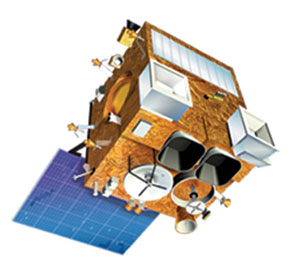University provides crucial tech to improve India's weather warnings
Release Date 30 July 2013
University of Reading experts have played a vital role in the development of a new satellite which could provide life-saving weather warnings to the people of India.
Reading researchers developed the crucial optical filters for the weather satellite on board the giant Ariane 5 rocket, launched last week from French Guiana.
These ‘eyes of the instrument' will measure the amount of contaminants and pollutants in the atmosphere, as well as the temperature, humidity and levels of other gases. The satellite will improve domestic weather forecasting and track potentially lethal cyclones and monsoons originating from the Bay of Bengal and Arabian Sea.
Launched from the spaceport of Kourou in French Guiana, the INSAT-3D meteorological satellite - India's latest, most advanced weather satellite - will enable more advanced weather forecasting and disaster warning services for India.
Dr Gary Hawkins, from the University of Reading's School of Systems Engineering, said: "These components, developed by our team at the University, will provide the crucial data needed by scientists and forecasters to better monitor extreme weather and provide life-saving warnings to people in India. This is just another example of the expertise of the Infrared Multilayer Laboratory at Reading being used internationally, alongside work with NASA and ESA on the replacement for the Hubble space telescope and the Mars Reconnaissance Orbiter."
Dr Andy Turner, from the University's Department of Meteorology, said: "India is very densely populated, and high levels of carbon from cooking fires and pollutants from factories are thought to be having a big impact on the climate and weather systems. This satellite will be a vital instrument in the monitoring of these pollutants, which can influence the monsoon season and other changes in weather. The observations that are made using the satellite will also help scientists improve climate models and predictions, meaning that more advanced warnings can be given."
The Ariane 5 rocket also carried Europe's biggest ever telecommunications satellite - prompting widespread coverage of the UK's increasing role in the space industry.
The University of Reading has the largest research capability in weather and climate science and Earth observation of any university in Europe. Reading is also working on a new collaboration, Global Satellite Sensing (GLOSS), with the University of Surrey at the National Physical Laboratory, to monitor changes to the Earth, its ecosystem and climate. It has also recently launched an innovative internship programme that will give students from universities across Europe a unique insight into the space industry.
ENDS
Notes for editors:
The Infrared Multilayer Laboratory, part of the University of Reading's School of Systems Engineering, is exclusively engaged in the research, development and supply of specialist high-quality infrared optics; ranging from coatings for single optical components, to the complete spectral design and manufacture of coatings for complex infrared space-flight atmospheric sensing and ground based astronomical instruments.
The laboratory has established and maintained a long heritage of research, and an internationally renowned reputation as experts at the forefront of thin-film engineering of optical coatings for deployment in state-of-the-art astronomy and planetary remote-sensing instrumentation.
The laboratory has been actively involved with projects for development of unique infrared optical components for instruments including ESA's Living Planet EarthCARE Multi-Spectral Imager (MSI), ESA GMES Sea and Land Surface Temperature Radiometer (SLSTR), NASA Lunar Reconnaissance Orbiter (LRO), NASA/ESA JWST Mid-Infrared Instrument (MIRI) and the ISRO SAC Indian National Satellite System (INSAT-3D) radiometer programmes. These missions are destined to provide global observations of land, ocean and atmospheric monitoring for use in meteorological theories on climate change, and the study of astrophysical properties of stars and other planetary objects.
